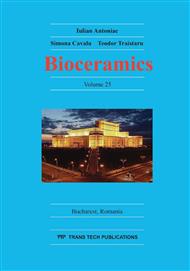p.56
p.63
p.69
p.74
p.80
p.86
p.93
p.97
p.103
Nano Calcium Phosphate Powder Production through Chemical Agitation from Atlantic Deer Cowrie Shells (Cypraea cervus Linnaeus)
Abstract:
The process is a simple chemical method and aims to produce nano-structured calcium phosphate powders from natural sources, for biomedical applications. For this purpose, Atlantic Deer Cowrie (ADC) shells (Cypraea cervus Linnaeus, 1771) were collected from a local gift store in Istanbul. The empty shells were cleaned and crushed then were ball milled and sieved under 100µm. The raw powders were suspended on a hotplate stirrer for a simple chemical agitation. The temperature was kept at 80°C for 15 min. and then appropriate amount of H3PO4 was added by titration into the prepared solution to form calcium phosphate precursors. The solution was stirred on a hotplate for 8 hours then dried at 100°C for 24 hours. Afterwards the resulting dried sediments were collected and heat treated between 400-800°C for 4 hours, dependent on the required specific calcium phosphate phase. X-ray diffraction (XRD) analysis and scanning electron microscopy (SEM) were carried out for identifying various hydroxyapatite (HA), tricalcium phosphate (TCP) and other calcium phosphate phases. Various particle sizes ranging from nano to micron, are obtained depending on the chemistry used and the processing technique applied during the production. A range of calcium phosphate phases can be obtained from ADC shells, by using a simple and economic conversion method. Proper cleaning methods developed and appropriate preparation techniques will enable us to use these nano calcium phosphate powders in orthopedic and dental applications.
Info:
Periodical:
Pages:
80-85
Citation:
Online since:
November 2013
Price:
Сopyright:
© 2014 Trans Tech Publications Ltd. All Rights Reserved
Share:
Citation:


